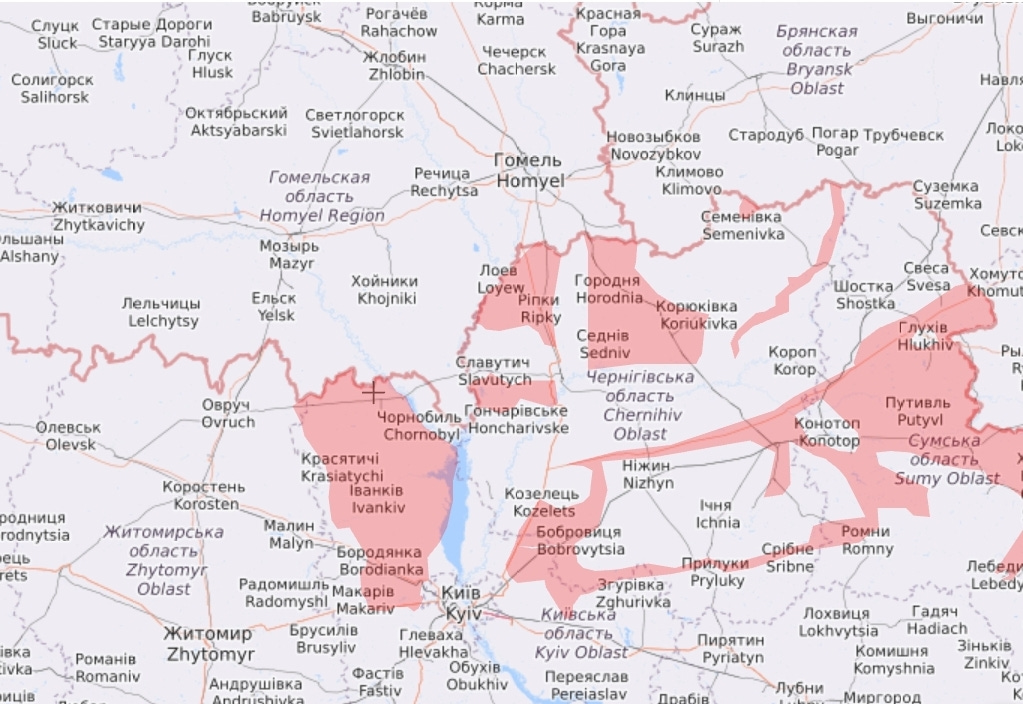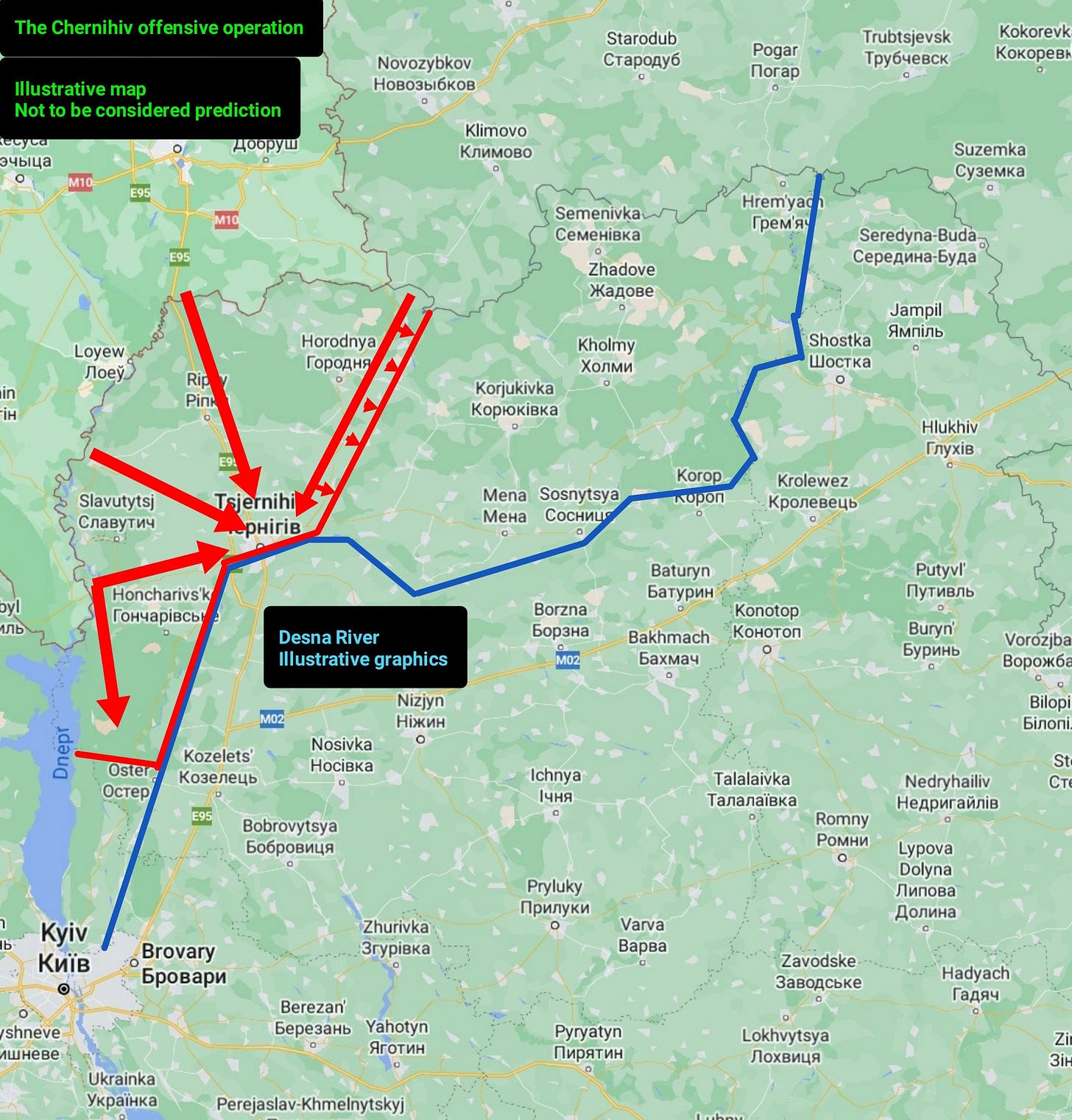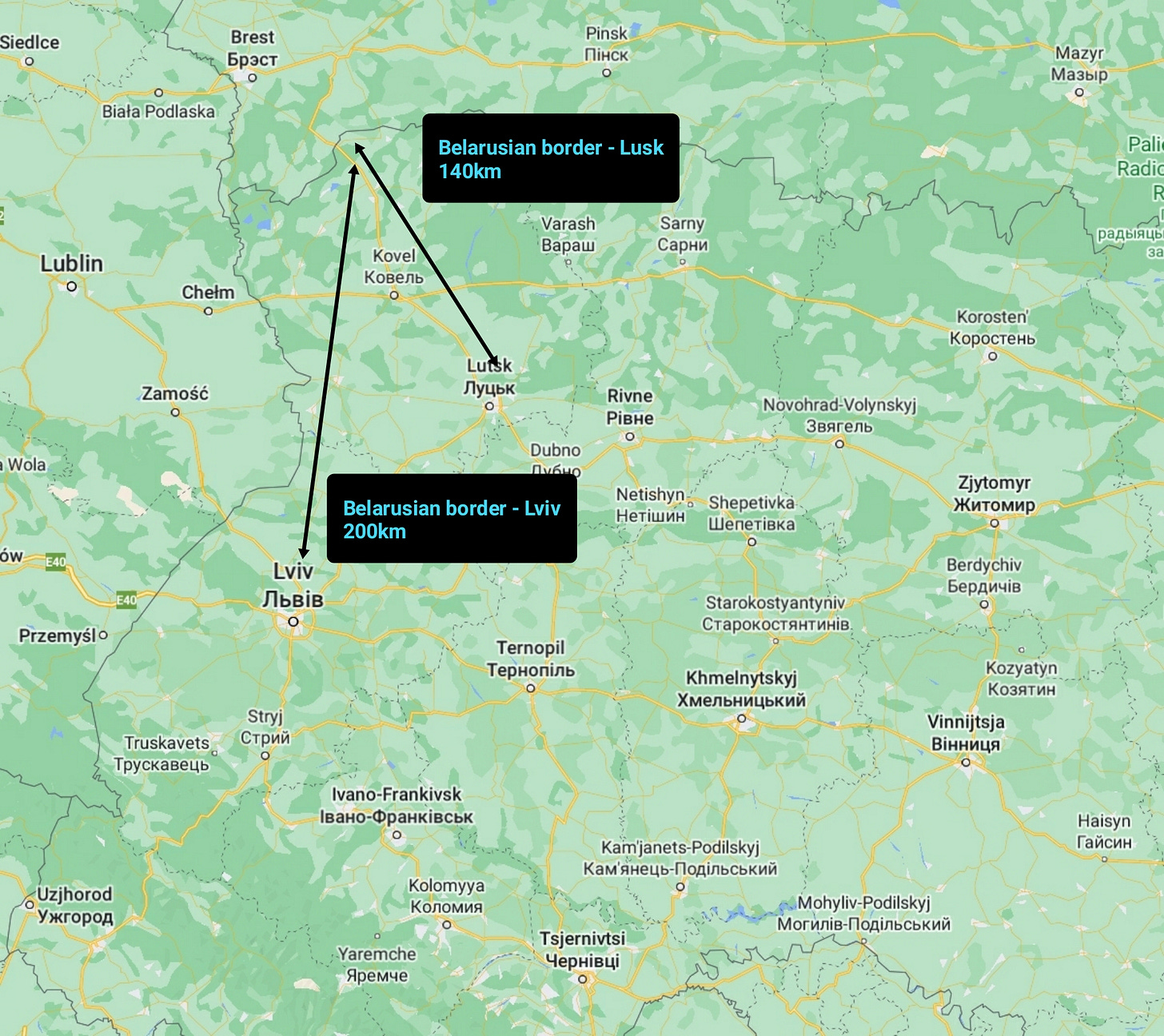A Russian winter offensive - Part 2
Possibilities on the northern front: Belarus and Bryansk Oblast
Liveuamap.com situation March 16th 2022
In this second article on a possible Russian winter offensive, I will look into and discuss the possibilities offered by the northern front. I do recommend reading Part 1 first, as that is necessary in order to see the overall picture I am painting. You'll find it here.
Don't consider this article prediction. While military activity in Belarus has been high this year, and Russian military presence increases, it is still too early to tell if an offensive from the north actually is in the making, and if so, what it would look like.
With that in mind, the purpose of my discussion is avoiding suprise by failure of imagination, and it hinges on the following assumptions and proposed Russian objective:
Key assumptions
Russia’s original war-aims remains unchanged and Moscow is planning for a long war.
Russian ammunition stockpiles, especially for artillery, are sufficient to support offensive operations this winter.
Russia is able to establish minimum one grouping of forces, which at least is capable of a limited operational level offensive operation.
The strike campaign against Ukrainian critical infrastructure continues.
Winter offensive - Proposed Russian strategic objective
Prevent large scale Ukrainian offensives this winter, regain the strategic initiative, and set the stage for further offensive operations in the summer of 2023
If Russia can munster sufficient strength, the northern front may offer larger opportunities for Russia than a winter offensive on the current active front. Such a move would force Ukraine to divert forces and reserves to meet the new threat. This could then help prevent a Ukrainian winter offensive, and also possibly weaken the existing lines.
Limited Ukrainian capability to target Russian territory beyond tube artillery range, with Belarus remaining completely off limits, gives Russia a safe haven for making preparations. This gives Russia flexibility in choosing where to strike.
The question of direct Belarusian participation
I have touched upon this subject before, in the article Belarus and a new attack from the north? Leaving the politics aside, placing the Belarusian Armed Forces under Russian command as per their wartime role, would add additional forces, easing the burden on the Russian military in creating an offensive grouping. While their quality may be debatable, Belarusian units could be used as a second echelon, support logistics, securing secondary flanks, or maintaining presence along quiet parts of the border in order to tie down Ukrainian forces.
Deception and a “fleet in being1”
Since the premise of the article is a possible winter offensive, most of the discussion rotates around that. However, I can't discuss the northern front without mentioning deception. One possibility is that the increasing military activity Belarus is to conduct some kind of show of force, or establish and maintain a land version of a fleet in being. The intention then could be to both fix Ukrainian forces along the border and prevent the release of reserves to the current active front.
The activation of the Regional Group of Forces in October and the subsequent deployment of Russian mobilized personell to Belarusian training grounds has by many been interpreted as an attempt at doing so.
As long as details from the recent high level meetings between Belarus and Russia also remains unknown, they generate a lot of speculation. Therefore it is possible to interpret this fog as deliberate, part of an attempt at deception.
The catch with this apporach is that for it to be effective over time, it needs to represent some kind of real offensive capability, that actually influences Ukrainian planning.
Geography and a short recap
The border area west of the Dnipro is shaped by the Polesie Marshes. A large area of wetlands and forests, with relatively few north-south roads and railway crossings.
This terrain generally isn't well suited for an offensive by modern, mechanized forces, but that didn't stop the Russians from advancing south from Mazyr, including through the Chernobyl Zone, towards Kyiv in February.
As one gets closer to the Polish border, the terrain somewhat improves, but there are still forests, wetlands and not too many roads.
The border in this area is characterized by forests, with the Desna River dividing Chernihiv Oblast in two. The Russians also unsuccessfuly advanced from Gomel towards Kyiv from the northeast in the opening phase, but fierce Ukrainian resistance around the city of Chernihiv contributed to the failure of this enterprise. The Desna line also helped prevent any meaningful link-up between the Russian grouping coming from the north and the one from the east, through Sumy Oblast.
Kyiv: The grand prize
“I have no doubt they will have another go at Kyiv.” - General Valery Zaluzhny, CINC Armed Forces of Ukraine, to the Economist
A second attempt at Kyiv often surfaces as the objective of a new offensive, but this idea is almost as often dismissed as being totally unrealistic. With Moscow's war-aims likely remaining unchanged, Kyiv likely still looks like the grand prize. A Russian success in capturing the city would be a major victory. A victory that could gloss over the mistakes of the past and provide a much needed morale boost, and a sense of purpose, to both the military and the Russian population.
Kyiv represents the heart of Ukraine. While loosing the capital likely wouldn't lead to a Ukrainian collapse, as it could have caused back in February, it would still represent a crushing defeat that would likely impact both morale and the will of the nation.
I'll leave aside the question of how feasible it actually is to conquer a city the size of Kyiv against determined resistace, which likely is difficult even in the best of circumstances, as that is a worthy study on its own.
If Russia wants to try to take the capital, but realizes it lacks the strength to do that now, a phased approach in another possibility. In this scenario the objective of a winter offensive is to capture ground and set the conditions for further advances later in 2023.
What I have tried to illustrate here is a winter offensive with the aim of securing a wider lodgement than in the initial invasion, but shallower in depth to account for reduced offensive potential. It would control more roads than the Russians had the last time and includes the Mazyr - Korosten railway. This lodgement could later then be expanded, and act as a bridgehead towards Kyiv in the spring/summer of 2023.
Even a reduced operation such as this would require substantial forces to be successful. Doubts on whether Russia could munster an offensive grouping for this, even with Belarusian participation and the mobilized units still in training, are likely well founded but a level of uncertainty does exist in that regard.
Ukraine also has a vote and have been preparing for a new attack on Kyiv, including building fortifications and defensive lines. Any Russian attack here would face stiff resistance, even if reinforcements have to be brought in from afar.
President Putin could of course order the Russian military to have another go at Kyiv, one way or the other, despite the Russian military's shortcomings. However, there are other smaller options, prehaps more realistic, which answers my proposed objective for an offensive this winter.
Chernihiv: Regional capital and stepping stone
Chernihiv offers several possibilities. Below is a sketch of a fairly large operation, aimed at capturing Chernihiv itself, a regional capital, and the territory between the Desna and Snov Rivers.
Being a relatively large operation, it would likely promt a substantial Ukrainian response to counter it. It also offers a lodgement for an advance on Kyiv from the northeast at a later stage.
Anchoring on river lines would make it easier to hold against counterattacks while preparing for further advances later, though launching a new offensive across the Desna could be a challenge. The attempted crossing of the Siversky Donets river at Bilohorivka has shown how difficult, and costly, opposed river crossing can be.
Force requirements for this option are likely smaller than any type of Kyiv scenario, and would also depend on how the Russians assess the likely Ukrainian response.
A small alternative is what I have dubbed a “fixing offensive”, here shown in Chernihiv, but this principle can also be applied on other sectors of the border with Belarus, and also from Bryansk and Kursk Oblasts.
The force requirements for this option would be smaller that those discussed earlier. It goes beyond the “fleet in being” by actually capturing territory, and by threatening a regional capital, it would force Ukraine to move forces to meet the threat and contain it.
This limited option would likely push forward the timeframe for operations exploiting the initial offensive, prehaps with a follow on offensive for the spring/summer of 2023 aimed at the Desna, with further advances planned for later. Stretching the timeframe could allow the Russian mobilization to gradually generate strength, by not over-committing outside the active front this winter.
Western Ukraine
An offensive in Western Ukraine is also mentioned at times. One possible objective could be to try and cut Ukrainian lines of communication to Poland. However, even by hinging the western flank on the Polish border, this would be a very large operation, likely requiring a larger force than the phased Kyiv operation, and certainly more than the Chernihiv-Desna alternative.
In a direct line, the distance from the Belarusian border to Lviv is approx 200km, and even reaching Lviv wouldn't cut Ukraine off. An advance south would also have a long, exposed eastern flank that would be very vulnerable to mobile Ukrainian counterattacks. For these reasons, I find the prospect of a larger offensive in the west unlikely, even if looking through 2023.
A smaller operation, akin to the Chernihiv “fixing offensive” is an option, but the prospect of such a move enabling future offensives in the west is also questionable. It would serve to draw away Ukrainian forces from elsewhere, but wouldn't offer any good opportunities for the future.
Establishing and maintaining a credible threat but not crossing the border looks to me like the best option in tying down Ukrainian units in this area, if Russia wants to do something here.
Summing up
At the current point in time, a possible Russian winter offensive from the north is mostly a theoretical exercise, though we have some indications of something in the making and the Ukrainians are voicing concerns.
There are many questions regarding the actual capability of the Russian Army at this stage, and what effect the mobilization can deliver in terms of replenishing existing units, creating new ones, and their actual combat capability. Putin's ambitions and other political considerations also plays a role and may override purely military considerations.
Munitions stockpiles is another important factor, and therefore all my examples rest on the planning assumption that the Russians have enough for atleast a limited offensive. Despite all these questions, underestimating Russia would be a grave mistake, one it seems Ukraine is trying to avoid.
What I hope I have achieved is to show that a Russian winter offensive from the north doesn't have to be a rerun of February and March 2022. There are many possibilities, and my examples are just that, examples, with an aim of widening the horizon.
Wars take on a life of their own, this war too, so there's a good chance what I have outlined will be overtaken by events. All the activity in Belarus could be deception, Belarus may not actively enter the war, Russia may not have strength for a winter offensive or Ukraine could strike first. However, do not be surprised if the Russians try to conduct an offensive somewhere this winter by a failing to imagine that it actually could happen.
Regards
The Lookout
Fleet in being - A naval force that because of its mere existence is a factor in the calculations of opposing strategists, even though it is inactive or is consigned to port.
Ukraine’s fateful winter - The Economist
The Belarusian Armed Forces: Structures, Capabilities, and Defence Relations with Russia - Konrad Muzyka










Excellent read. Thoughly enjoyed your analysis.